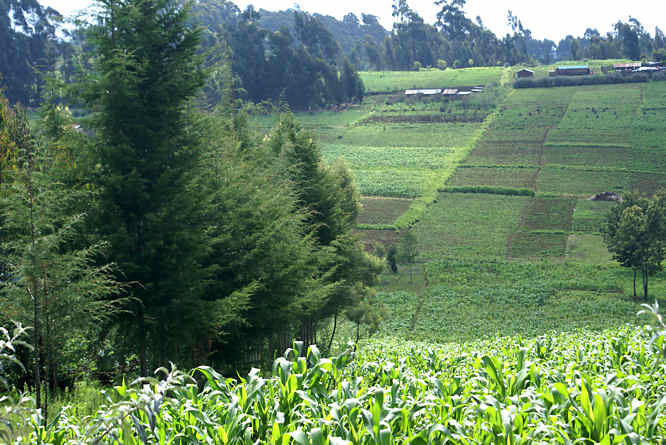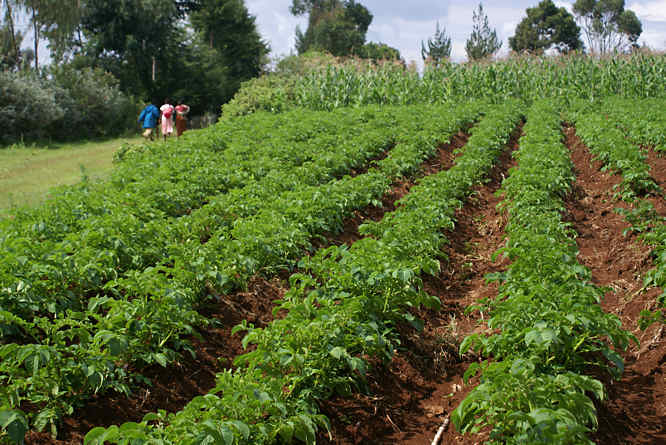Nakuru Countryside Kenya
In Nakuru I met my friend Jackson Wahome. He wanted to show us where he lived as a boy. His village was about 15 miles outside Nakuru. The deep red brick coloured dirt road was in a good firm condition. The morning rain had suppressed the road dust. Jackson asked me to stop as we went through a small town. He needed to buy a top up card for his mobile phone. There was a Safaricom telecommunications sign nailed to the top of a wooden hut. The building looked like an old ram shackled Victorian terraced house's outside toilet, but it had a stable door.

After a successful purchase Jackson went to a nearby street seller and brought some raw sugar cane. It looked like chunks of bamboo. It was safe to eat, as you had to peel away the outer husk and chew on the sweet middle. It had a woody texture and was too sweet for my taste buds. It is a bit like marmite, you either love it or hate it.
At the edge of the town Jackson told me to take the next side turning on the left. The open farm land near the town had changed into dense tropical green forest. It felt claustrophobic. Jackson's childhood village home was three miles up the road. As a boy he had carried bags of potatoes and maize grown on his family plot of land, into town to sell. Today the excess crops are taken to a nearby village. There they are collected by lorries and taken to sell in the large city of Nairobi or Nakuru.
The recent rains had caused problems. The surface of this country road had been ripped apart by those heavy large vegetable collection lorries. Rather than being flat the road was now a U shape. The lower centre was a muddy quagmire of deep tyre tracks. Only the higher edges had firm ground

I kept the near side wheels on the firm ground of the road edge. The four wheel drive system of the 30 year old Classic Range Rover handled the situation with ease. After about a mile the road started to go down hill as if we were heading for a valley. The tyre ruts were getting deeper as the mud was getting softer because of the downward accumulation of runoff water. As I drove around a bend I saw one of the large Bedford 4 tonne collection lorries about 150 yards in front. It was stuck. The mud was over its axels. The villagers were out in force unloading the crops to lighten the vehicle. Others were hacking down trees and placing them under the tyres. If that lorry, with its very high ground clearance, could not negotiate those muddy ruts my Range Rover would certainly get stuck.
As this thought was going through my mind the range rover suddenly started moving sideways. I was only doing about 5 mph. The rear end was moving towards a large tree on the other side of the road. I came off the accelerator and tried to counter steer into the skid. Nothing happened. The car had a momentum of it's own. I was not in control. All I could do was wait for the expected thump as we hit the tree, but nothing happened. The range rover stopped about one inch from the hazard. I started to breath again. The car was now at a right angle across the road. 'What am I going to do now?' I thought, 'I am in the middle of Africa. Miles away from any help and without a winch, in the middle of a deep muddy slippery mess.' I then remembered the low gear four wheel drive switch.
I had read up about using this lower gear selector but had never used it before. I had been told that on this vehicle you had to turn off the engine before selecting the switch. This I did. My passengers were confused. I explained what I was trying to do. My expectations of success were very low. I envisioned being knee deep in mud very soon, trying to find logs to put under the tyres. I restarted the engine and gentle depressed the accelerator. I was shocked. The ultra low four wheel drive torque setting enabled this wonderful old classic car to find grip in the mud at an extremely slow speed. I was grinning like the Cheshire cat. I love Range Rovers. What a fantastic machine. I was so thrilled and relived to have successfully got out of that deep slippery muddy boggy mire.
I drove back to the main road without any further problems. Jackson then directed me to his mother's house via a donkey track. It was on top of a nearby lush tropically forested hill that had a few farmsteads placed irregularly on its brow. My British made mechanical donkey had no problems climbing the gradient. This rocky track was dry and firm. We were in for a very humbling experience. Jackson's mother was a widow and lived with her youngest son and daughter in two rectangular mud huts with rusty corrugated iron roofs.
She farmed a small plot of land hacked out of the tropical forest by here late husband. She had invited her friends to come and meet us and help with the cooking. We did not realise that a feast had been planned in our honour. Jackson said to me, 'You realise that you have made my mother very proud. She will be the talk of the area for months. The last white man to come up here was a missionary about thirty years ago.'
After Jackson introduced us to all his family and his mother's friends we were given the guided tour. The outer walls of the two large rectangular mud buildings were very roughly finished. I was expecting to find the same condition inside. I was so shocked when I walked inside. I was speech less for a few moments as I took everything in. All four internal walls were smooth and straight as if a professional plasterer had finished them. Six foot long white lace curtains were draped along each wall to lighten the room and add decoration to the walls.
This was sensible as paint or wallpaper would just peal and crack. I counted two, three seater sofas and six big upholstered chairs lining the wall. In the middle of the room was a large coffee table. The fabric used on the furniture was very bold and colourful. All the furniture looked new. 'We have skilled craftsmen in the village and wood is cheap. They make good furniture,' Jackson explained, 'please have a seat.'
The sofas and chairs looked out of place in a mud hut. I was not expecting this level of luxury. Clean pure water was obtained from an artesian well dug deep into the porous volcanic bedrock. Two solar panels on the roof provided electrical power for the radio and a light bulb. Excess power was stored in a battery.
Some posters were attached to the curtains to further decorate the smooth mud wall. These too seemed out of place in an African mud hut. At one end of the room was a large poster of Arnold Schwarzenegger as the terminator. At the other end was a poster of Kate Winslet and Leonardo DiCaprio from the film Titanic. Around the edges were smaller missionary religious posters that used photographs of white children to illustrate their messages about God. This is black Africa. Why use photographs of white children? As guests of honour we were served with a meal of chicken, sweetcorn and potatoes. All home grown on the farm, freshly picked and killed that morning.
Travel books

